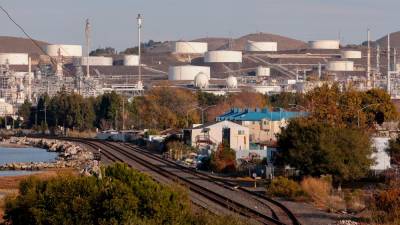
NEW YORK: Oil prices climbed about 2% to a near three-month high on Monday (July 24) on tightening supply, rising US petrol demand, hopes for Chinese stimulus measures and technical buying.
Brent futures rose US$1.67, or 2.1%, to settle at US$82.74 (RM378.78) a barrel, while US West Texas Intermediate (WTI) crude rose US$1.67, or 2.1%, to settle at US$78.74 (RM360.47).
Those were the highest closes for Brent since April 19 and for WTI since April 24, as both contracts were pushed into technically overbought territory above their 200-day moving averages.
The 200-day moving average had been a key point of technical resistance for both benchmarks since August 2022.
Bob Yawger, director of energy futures at Mizuho Bank, said a move above the 200-day moving average “generally stops out the (speculative) shorts (and) attracts traders looking for new entry points”.
Both crude benchmarks have already climbed for four weeks in a row with supplies expected to tighten due to cuts from the Organization of the Petroleum Exporting Countries (Opec) and allies like Russia, a group known as Opec+.
Oil’s rise has reflected “tightening conditions as Saudi oil output cuts impact the market ... even as summer demand has been somewhat stronger for gasoline (petrol) and jet fuel,” Citi Research said in a note.
Strong demand and worries about supply issues boosted US petrol futures to their highest level since October 2022.
“The rally in crude oil is impressive as it occurs as Europe is looking very weak right now, the US is slowing down, and China’s Politburo isn’t expected to unveil major stimulus this week,” Edward Moya, senior market analyst at data and analytics firm Oanda, said in a note.
In the eurozone, business activity shrank much more than expected in July as demand in the bloc’s dominant services industry declined while factory output fell at the fastest pace since Covid-19 first took hold, a survey showed.
In the US, business activity slowed to a five-month low in July, dragged down by decelerating service-sector growth, closely watched survey data showed, but falling input prices and slower hiring indicate the Federal Reserve (Fed) could be making progress on important fronts in its bid to reduce inflation.
Investors have priced in quarter-point increases from the Fed and the European Central Bank (ECB) this week, so the focus will be on what Fed chair Jerome Powell and ECB president Christine Lagarde say about future rate increases.
A majority of economists polled by Reuters still expect this will be the last increase of the current US tightening cycle, after data this month showed signs of disinflation, eliminating the need for the Fed to lift rates further.
Higher interest rates increase borrowing costs and can slow economic growth and reduce oil demand.
In China, the world’s second-largest economy and second-biggest oil consumer, leaders pledged to step up policy support for the economy amid a tortuous post-Covid recovery, focusing on boosting domestic demand, signalling more stimulus steps.
Analysts at Deutsche Bank said demand for oil in China “is now surpassing expectations”, which “helps to add confidence in the ability of China to make up (two-thirds) of oil demand growth this year.” – Reuters
Source: The Sun Daily
A word from our sponsor:
Need Help With Your Personal Finance / Money Issue or need a coach to help you structure or just want to learn the financial skill to self manage your financial matters and retirement. iLearnFromCloud.com
Need to solve a problem quickly, now you can solve it by learning the art of problem solving Art Of Problem Solving
Feeling hungry. Latest food news from Best Restaurant To Eat Malaysian Food and Travel Blog
Memory loss. Need to organize better. Solve problem fast with Free Mind Mapping Software Mind Mapping 101
Need A Customized System Development for your business or Going Paperless XPERT TECHNOLOGIES - Empowering The Paperless Economy

No comments:
Post a Comment